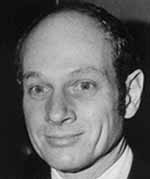 |
|
Cronin by Mike Perricone
But living in the real world of science, which runs on funding, Cronin knows the importance of trading on the prestige of those awards. "It's a wonderful individual honor, but it does have a lot of practical value," Cronin said from Paris, where he holds the International Chair at the CollĖge de France. The National Medal of Science, administered by the National Science Foundation, was established by Congress in 1959, with 374 recipients including 12 for 1999. Previous winners have included Robert R. Wilson, founding director of Fermilab, and Norman Ramsey, founding president of Universities Research Association, Inc. In his presentation at the March 14 White House ceremony, President Clinton cited Cronin "for fundamental contributions to the fields of elementary particle physics and astrophysics and as a leader in creating an international effort to determine the unknown origins of very high-energy cosmic rays." Cronin is co-leader (with Alan Watson of the University of Leeds, England) of the Pierre Auger Observatory, a collaboration of more than 250 scientists and engineers from 60 institutions in 19 countries ("The High-Energy Cosmic Mystery," FERMINEWS, Vol. 2, No. 8, April 16, 1999). High-energy cosmic rays carry an energy more than 100 times that of Fermilab's Tevatron, the world's highest-energy particle accelerator. When completed, in the Mendoza province of Argentina, the observatory will use 1,600 surface detectors (tanks holding 3,000 gallons of water) and four fluorescent detectors to investigate the cosmic ray mystery. Fermilab is the host institution for Auger Project management, which has reached the stage of installing what is called the "engineering array": 40 prototype surface detectors and one fluorescent detector to test the designs before going into full production. Mounting an international experiment in a remote area of Argentina poses challenges that Cronin can confront more effectively with the help of the National Medal of Science and the access it offers. "Winning this prize is extremely timely because the citation does not focus just on the past, but refers to the work I'm doing now," Cronin explained. "I made use of that right away." In Paris, Cronin met with Koichiro Matsuura, who is the Director-General of UNESCO (United National Educational, Scientific and Cultural Organization) as well as Japan's ambassador to France. Cronin asked Matsuura for assistance in gaining waivers of customs duties on equipment bound for the Auger site in Argentina. Cronin noted that the U.S. is no longer a UNESCO partner, though the organization has longstanding ties to the Auger project. "UNESCO was very important in the early days of the Auger project, helping us set up the international agreement to finance the project," Cronin said. "Whenever I can make use of my contacts, I try to encourage the U.S. to rejoin UNESCO." The National Medal of Science and the Washington trip also offered domestic benefits. "It permitted me to have meetings with Neal Lane, the President's chief science advisor, asking him to help influence the government of Argentina," Cronin said. "The new government of Argentina has financial difficulties and may not fulfill its commitment for Auger funds this year. I hoped we could use the power of our government to encourage the Argentine government." Cronin has been a White House guest before. He was invited to the Oval Office by President Carter after winning the Nobel Prize in 1980, a time of turmoil during the Iran hostage crisis. Cronin also participated in a ceremony on the White House lawn, celebrating the inauguration of the ill-fated Superconducting Super Collider. The ceremony for the National Medal of Science, and for the National Medal of Technology administered by the Department of Commerce, took place in the Blue Room. Cronin remembered waiting with family members and other award winners for the proceedings to begin while the President spoke on the phone with British Prime Minister Tony Blair, formulating a policy statement on public access to all research in the Human Genome Project. "That provided the substance of Clinton's speech before the presentations," Cronin said. "I was impressed that the President was so much at ease in speaking with us before the ceremony. He talked about how much he enjoys these [scientific] subjects, and clearly he was very much in command. He wasn't using note cards. He had given a talk at the University of Chicago graduation the previous year, and he chatted about the University, and how impressed he was by the standards there." Following the ceremony, the award winners and their families were "given free reign of the public areas in the White House," as Cronin described it. The views looking outward, to the Washington Monument and the Jefferson Memorial, were moving. "We're always complaining about the government, but that setting transcends those thoughts," Cronin said. "It was a wonderful reception, and very impressive. One takes satisfaction that the nation does honor its scientists." |
| last modified 4/14/2000 email Fermilab |
FRLsDFx9eyfrPXgV
 The 1999 National Medal of Science and the 1980 Nobel Prize are life-defining honors that James Cronin wouldn't trade for anything in the world.
The 1999 National Medal of Science and the 1980 Nobel Prize are life-defining honors that James Cronin wouldn't trade for anything in the world.